Publications
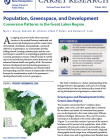
December 11, 2018
An ongoing concern in both urban and rural America is the tradeoff between residential and commercial development and the conservation of forestland, shrublands, and grasslands, commonly referred to as greenspace. As communities develop, adding schools, housing, infrastructure, and the commercial space needed for an expanding population and economy, greenspace remains critical because it…

December 6, 2018
New Hampshire received a significant net inflow of people from other U.S. states between 2013 and 2017 according to new Census Bureau estimates. The average annual domestic migration gain was 5,900 between 2013 and 2017

November 13, 2018
Increases in the minimum wage are widely assumed to be beneficial for low-income workers, but it is important to consider the effect an increase might have on eligibility for other benefits, particularly the federal Earned Income Tax Credit (EITC). This fact sheet examines the interaction between the minimum wage and the EITC to determine whether a minimum wage increase would produce gains in the…

October 31, 2018
The share of people without health insurance has dropped dramatically since the implementation of the Affordable Care Act (ACA), but declines have been most dramatic among young adults age 19 to 25. In 2008, one-in-three 23-year-olds were uninsured, likely reflecting their graduation from college and therefore, their ineligibility to be covered on parental plans. Beginning in 2010, the ACA…

October 30, 2018
In this report, author Jean Bessette examines the U.S. Department of Agriculture (USDA) Summer Food Service Program (SFSP) operating in 2017 in four communities in Coös County, New Hampshire. She reports that the SFSP provides benefits to Coös County on multiple levels. For children, it ensures the availability of nutritious meals in the summer when school meal programs are not operating; for…

October 9, 2018
Recent proposals in the House and Senate (for example, the Grow American Incomes Now Act) focus on amplifying the Earned Income Tax Credit (EITC)—a refundable tax credit for low-income workers—to compensate for growing wage inequity. We find that the share of EITC filers who are families with children is especially high in the poorest counties (those counties outlined in black on Map 1),…

September 14, 2018
Recent National Center for Health Statistics data show a record low birth rate in the United States, and no evidence of any upturn in this birth rate. Though other social and economic factors may also be influencing U.S. birth rates, the impact of the Great Recession persists. I estimate that in 2017, there were 700,000 fewer births in the United States than would have been expected had pre-…
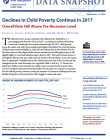
September 13, 2018
The official poverty measure indicates that child poverty declined by 1.1 percentage points between 2016 and 2017, according to analyses of the latest American Community Survey data released today. By 2017, child poverty across the nation was still 0.4 percentage point higher than before the Great Recession. Child poverty remained higher in cities and rural places than in the suburbs. For the…
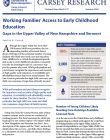
September 5, 2018
Although the Upper Valley has more than 200 licensed child care providers, the corresponding number of licensed slots is about 2,000 short of the estimated number of young children who likely need early care and education. Early childhood is a critical developmental period, and access to early childhood education is essential not only for learning but also as a necessary support for parents who…
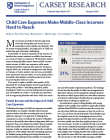
August 29, 2018
Most Americans believe that through hard work and saving they can secure an economically sound, middle-class lifestyle.1 But for many working families, the high price of child care makes this goal extremely challenging.
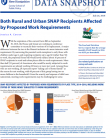
July 26, 2018
With the expiration of the current Farm Bill on September 30, 2018, the House and Senate are working in conference committee to reconcile their versions of its replacement. A major difference between the two is the House’s inclusion of a more intensive work requirement. By narrowing the parental work exemption to only those with children under age 6, and requiring recipients up to age 60 (rather…

July 5, 2018
This policy brief explains that people who live in rural America rely more heavily on the federal Food Stamp Program than do residents of urban areas. The brief presents a demographic picture of rural food stamp recipients, including information on income, race, age, and family size. It also compares data for rural and urban recipients.
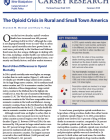
June 19, 2018
Over the last two decades, opioid overdose deaths have increased over 400 percent, reaching 45,838 in 2016. Although the crisis is not disproportionately worse in rural than in urban America, opioid mortality rates have grown faster in rural areas, particularly in the Northeast and Midwest. Rural areas also face unique challenges in dealing with the crisis, including a smaller health care…

June 5, 2018
Hidden in the shadows of New Hampshire’s opioid epidemic are the children who live with their parents’ addiction every day. They fall behind in school as the trouble at home starts to dominate their lives, they make the 911 calls, they are shuttled about to live with relatives or in foster care, and they face an uncertain future when their parents can no longer care for them.
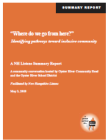
May 3, 2018
This report presents results from a community conversation aimed at identifying pathways toward an inclusive and bias-free community. The conversation served as the closing community event of the Oyster River Community Read (ORCR) Program that ran from January to April 2018. The goal of this conversation was to increase understanding, generate ideas for change, and help participants get…

April 10, 2018
New Hampshire’s ocean coastline, though small relative to that of other states, is a place where people have lived, worked, and died for thousands of years. It is home to numerous important cultural heritage sites,1 and its identity is tied in tangible and intangible ways to centuries of marine-based ways of life.2 Tourism to the region’s remnant historic heritage sites and cultural landscapes is…
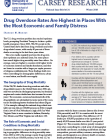
March 27, 2018
The U.S. drug overdose problem has reached epidemic levels, prompting President Trump to declare a public health emergency. Since 2000, 786,781 people in the United States have died from drug overdoses and other drug-related causes, with nearly 40 percent of those deaths occurring in the last three years alone.
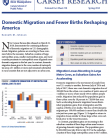
March 22, 2018
New Census Bureau data released on March 22, 2018, demonstrate the continuing influence of domestic migration on U.S. demographic trends. Migration patterns are reverting to those common before the recession. Suburban counties of large metropolitan areas, smaller metropolitan areas, and rural counties proximate to metropolitan areas all gained more domestic migrants in the last year. In contrast…
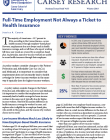
March 20, 2018
The majority of Americans—55.7 percent in 2016, according to the Census Bureau—access health insurance through employer-based plans.1 However, employment does not always result in health insurance coverage, and not all those who report working full time, year round are covered by an employer-based plan. In particular, many low-income workers are unable to access health insurance through their…

March 13, 2018
From more frequent flooding to heat waves and drought, adverse impacts from climate change are already being experienced. Scientists warn of worse impacts within the lifetime of many people alive today, if greenhouse gas emissions are not reduced. Although majorities in all age groups recognize the reality of climate change, awareness is highest among young adults.
